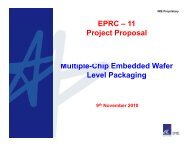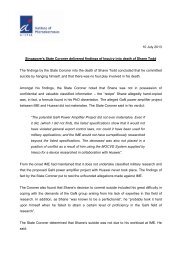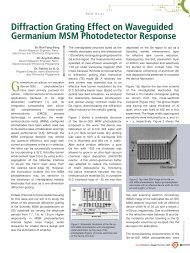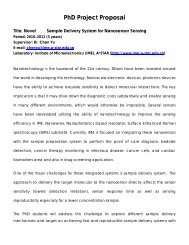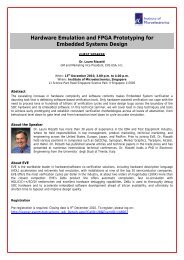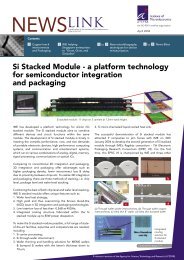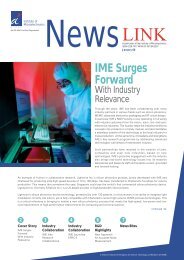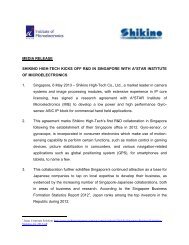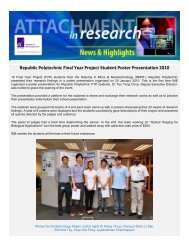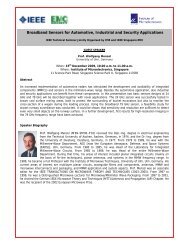Proposal for a PhD Thesis - Institute of Microelectronics - A*Star
Proposal for a PhD Thesis - Institute of Microelectronics - A*Star
Proposal for a PhD Thesis - Institute of Microelectronics - A*Star
Create successful ePaper yourself
Turn your PDF publications into a flip-book with our unique Google optimized e-Paper software.
<strong>PhD</strong> Project <strong>Proposal</strong><br />
Title: Integrated circuits <strong>for</strong> energy transfer & management in implantable<br />
microsystems<br />
Period: 2010–2012 (3 years)<br />
Supervisor: Dr. Minkyu Je<br />
E-mail: jemk@ime.a-star.edu.sg<br />
Laboratory: <strong>Institute</strong> <strong>of</strong> <strong>Microelectronics</strong> (IME), A*STAR, Singapore (http://www.ime.astar.edu.sg)<br />
Since energy is such an essential resource in implantable biomedical systems, it must be<br />
efficiently transferred and managed. To supply energy to implanted devices, wireless<br />
electromagnetic energy transfer is an effective and proven technique. It involves<br />
transmitting electromagnetic energy into the body and collecting it via a coil or antenna.<br />
Low-frequency electromagnetic energy transfer is currently used in cochlear implants,<br />
radio-frequency identification (RFID) implants, retinal prosthetics, and neurostimulators.<br />
Near-field wireless energy transfer results in electromagnetic fields that can heat tissue and<br />
generate electromagnetic interference on nearby electronics. Hence, the wireless link<br />
must meet regulatory guidelines. For small implanted applications, where volume<br />
constraints limit the size <strong>of</strong> the receive coil, the practical range <strong>of</strong> energy transfer is limited<br />
to a few centimeters. So, researchers have worked on design optimization and invention<br />
<strong>of</strong> new techniques to increase the transfer distance and efficiency. Going further, energy<br />
gathering is most useful and flexible when harvesting ambient energy, in which the source<br />
<strong>of</strong> energy exists inherently as part <strong>of</strong> the system. An emerging approach that exploits true<br />
ambient energy is vibrational and thermal energy harvesting from the user’s movement<br />
and skin temperature respectively.<br />
The voltage converter is another important component in the energy subsystem. For a<br />
biomedical device, it must be optimized <strong>for</strong> the voltage and current required by the load.<br />
Energy-efficient CMOS circuits operate <strong>of</strong>f a supply voltage at or below 1 V, and most<br />
biomedical applications require currents between a few microamps to a few milliamps. To<br />
generate these voltages, a step-down (buck) converter is required. When only a small<br />
step-down is required, a low drop-out (LDO) linear regulator is a simple and robust<br />
approach; however, <strong>for</strong> a large step-down, the efficiency <strong>of</strong> an LDO is poor and switching<br />
regulators are preferred. The two main voltage converter topologies are switched<br />
capacitor–based and inductor/trans<strong>for</strong>mer–based switching converters.<br />
In this <strong>PhD</strong> thesis project, it is proposed to develop high-efficiency energy transfer circuits<br />
interfacing with a micro-coil <strong>for</strong> wireless energy transfer and ambient energy harvesters,
and voltage converters delivering optimal supply to the load. The new circuit design<br />
should be able to meet the simultaneous requirements <strong>of</strong> very small <strong>for</strong>m factor and high<br />
efficiency down to very low energy level, which are critical <strong>for</strong> implantable microsystems.<br />
The main objectives <strong>of</strong> the <strong>PhD</strong> thesis are as follow:<br />
1. To study the governing mechanisms which determine the power transfer and<br />
conversion efficiency.<br />
2. To develop advanced approaches and techniques to design the high-efficiency<br />
energy transfer and conversion circuits.<br />
3. To demonstrate the developed energy transfer and management circuits within<br />
actual implantable microsystems such as a sensorized prosthetic vascular graft.<br />
The major activities <strong>of</strong> the <strong>PhD</strong> thesis will include literature study, modeling <strong>of</strong> energy<br />
transfer coils and energy harvesters, circuit design, simulation and layout, test setup<br />
development, and electrical/in-vitro/in-vivo testing. Most <strong>of</strong> these activities will be based<br />
on the facilities run in the Integrated Circuits and Systems Laboratory at IME, where the<br />
relevant CAD tools and test equipments are available. In-vitro and in-vivo testing will be<br />
carried out under collaboration with Bio Electronics Programme at IME and National<br />
University Hospital (NUH), Singapore.



